Yizhao Gao
SeerAttention-R: Sparse Attention Adaptation for Long Reasoning
Jun 10, 2025



Abstract:We introduce SeerAttention-R, a sparse attention framework specifically tailored for the long decoding of reasoning models. Extended from SeerAttention, SeerAttention-R retains the design of learning attention sparsity through a self-distilled gating mechanism, while removing query pooling to accommodate auto-regressive decoding. With a lightweight plug-in gating, SeerAttention-R is flexible and can be easily integrated into existing pretrained model without modifying the original parameters. We demonstrate that SeerAttention-R, trained on just 0.4B tokens, maintains near-lossless reasoning accuracy with 4K token budget in AIME benchmark under large sparse attention block sizes (64/128). Using TileLang, we develop a highly optimized sparse decoding kernel that achieves near-theoretical speedups of up to 9x over FlashAttention-3 on H100 GPU at 90% sparsity. Code is available at: https://github.com/microsoft/SeerAttention.
Rectified Sparse Attention
Jun 05, 2025Abstract:Efficient long-sequence generation is a critical challenge for Large Language Models. While recent sparse decoding methods improve efficiency, they suffer from KV cache misalignment, where approximation errors accumulate and degrade generation quality. In this work, we propose Rectified Sparse Attention (ReSA), a simple yet effective method that combines block-sparse attention with periodic dense rectification. By refreshing the KV cache at fixed intervals using a dense forward pass, ReSA bounds error accumulation and preserves alignment with the pretraining distribution. Experiments across math reasoning, language modeling, and retrieval tasks demonstrate that ReSA achieves near-lossless generation quality with significantly improved efficiency. Notably, ReSA delivers up to 2.42$\times$ end-to-end speedup under decoding at 256K sequence length, making it a practical solution for scalable long-context inference. Code is available at https://aka.ms/ReSA-LM.
Awaker2.5-VL: Stably Scaling MLLMs with Parameter-Efficient Mixture of Experts
Nov 16, 2024Abstract:As the research of Multimodal Large Language Models (MLLMs) becomes popular, an advancing MLLM model is typically required to handle various textual and visual tasks (e.g., VQA, Detection, OCR, and ChartQA) simultaneously for real-world applications. However, due to the significant differences in representation and distribution among data from various tasks, simply mixing data of all tasks together leads to the well-known``multi-task conflict" issue, resulting in performance degradation across various tasks. To address this issue, we propose Awaker2.5-VL, a Mixture of Experts~(MoE) architecture suitable for MLLM, which acquires the multi-task capabilities through multiple sparsely activated experts. To speed up the training and inference of Awaker2.5-VL, each expert in our model is devised as a low-rank adaptation (LoRA) structure. Extensive experiments on multiple latest benchmarks demonstrate the effectiveness of Awaker2.5-VL. The code and model weight are released in our Project Page: https://github.com/MetabrainAGI/Awaker.
SeerAttention: Learning Intrinsic Sparse Attention in Your LLMs
Oct 17, 2024



Abstract:Attention is the cornerstone of modern Large Language Models (LLMs). Yet its quadratic complexity limits the efficiency and scalability of LLMs, especially for those with a long-context window. A promising approach addressing this limitation is to leverage the sparsity in attention. However, existing sparsity-based solutions predominantly rely on predefined patterns or heuristics to approximate sparsity. This practice falls short to fully capture the dynamic nature of attention sparsity in language-based tasks. This paper argues that attention sparsity should be learned rather than predefined. To this end, we design SeerAttention, a new Attention mechanism that augments the conventional attention with a learnable gate that adaptively selects significant blocks in an attention map and deems the rest blocks sparse. Such block-level sparsity effectively balances accuracy and speedup. To enable efficient learning of the gating network, we develop a customized FlashAttention implementation that extracts the block-level ground truth of attention map with minimum overhead. SeerAttention not only applies to post-training, but also excels in long-context fine-tuning. Our results show that at post-training stages, SeerAttention significantly outperforms state-of-the-art static or heuristic-based sparse attention methods, while also being more versatile and flexible to adapt to varying context lengths and sparsity ratios. When applied to long-context fine-tuning with YaRN, SeerAttention can achieve a remarkable 90% sparsity ratio at a 32k context length with minimal perplexity loss, offering a 5.67x speedup over FlashAttention-2.
Co-designing a Sub-millisecond Latency Event-based Eye Tracking System with Submanifold Sparse CNN
Apr 22, 2024Abstract:Eye-tracking technology is integral to numerous consumer electronics applications, particularly in the realm of virtual and augmented reality (VR/AR). These applications demand solutions that excel in three crucial aspects: low-latency, low-power consumption, and precision. Yet, achieving optimal performance across all these fronts presents a formidable challenge, necessitating a balance between sophisticated algorithms and efficient backend hardware implementations. In this study, we tackle this challenge through a synergistic software/hardware co-design of the system with an event camera. Leveraging the inherent sparsity of event-based input data, we integrate a novel sparse FPGA dataflow accelerator customized for submanifold sparse convolution neural networks (SCNN). The SCNN implemented on the accelerator can efficiently extract the embedding feature vector from each representation of event slices by only processing the non-zero activations. Subsequently, these vectors undergo further processing by a gated recurrent unit (GRU) and a fully connected layer on the host CPU to generate the eye centers. Deployment and evaluation of our system reveal outstanding performance metrics. On the Event-based Eye-Tracking-AIS2024 dataset, our system achieves 81% p5 accuracy, 99.5% p10 accuracy, and 3.71 Mean Euclidean Distance with 0.7 ms latency while only consuming 2.29 mJ per inference. Notably, our solution opens up opportunities for future eye-tracking systems. Code is available at https://github.com/CASR-HKU/ESDA/tree/eye_tracking.
Event-Based Eye Tracking. AIS 2024 Challenge Survey
Apr 17, 2024
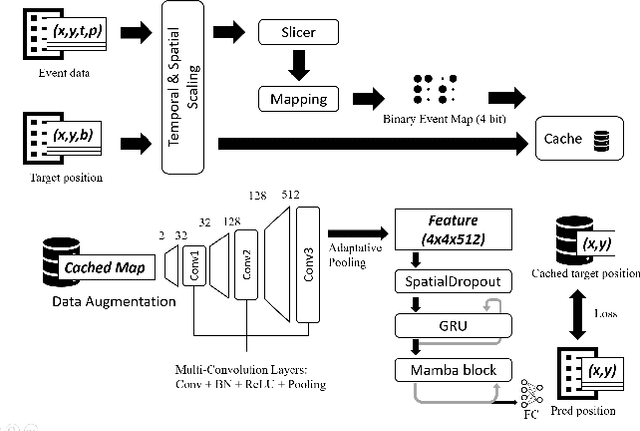
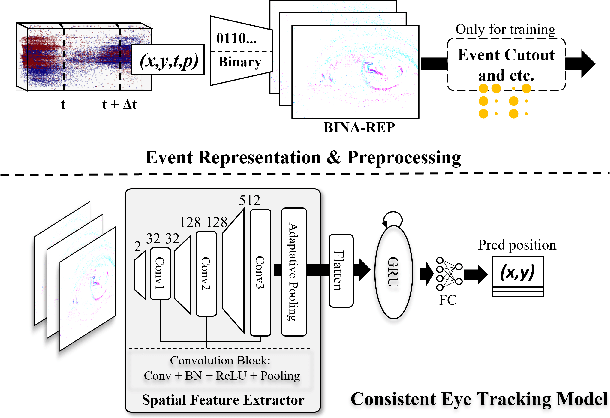

Abstract:This survey reviews the AIS 2024 Event-Based Eye Tracking (EET) Challenge. The task of the challenge focuses on processing eye movement recorded with event cameras and predicting the pupil center of the eye. The challenge emphasizes efficient eye tracking with event cameras to achieve good task accuracy and efficiency trade-off. During the challenge period, 38 participants registered for the Kaggle competition, and 8 teams submitted a challenge factsheet. The novel and diverse methods from the submitted factsheets are reviewed and analyzed in this survey to advance future event-based eye tracking research.
Random resistive memory-based deep extreme point learning machine for unified visual processing
Dec 14, 2023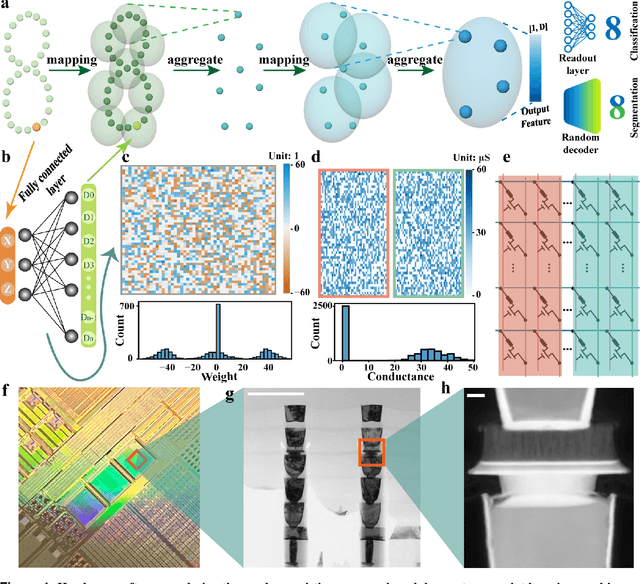
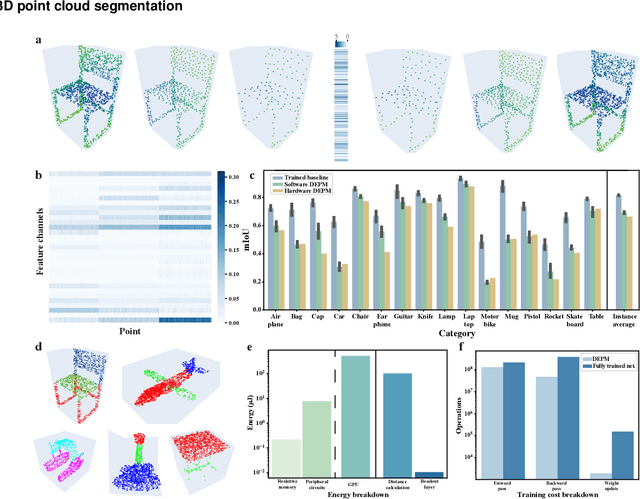
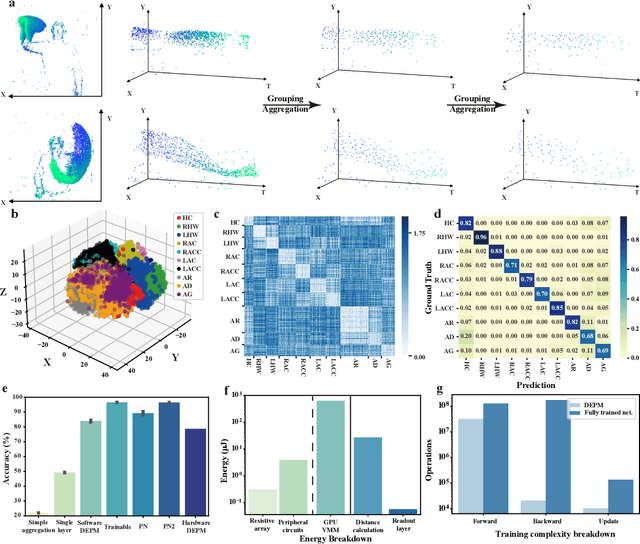
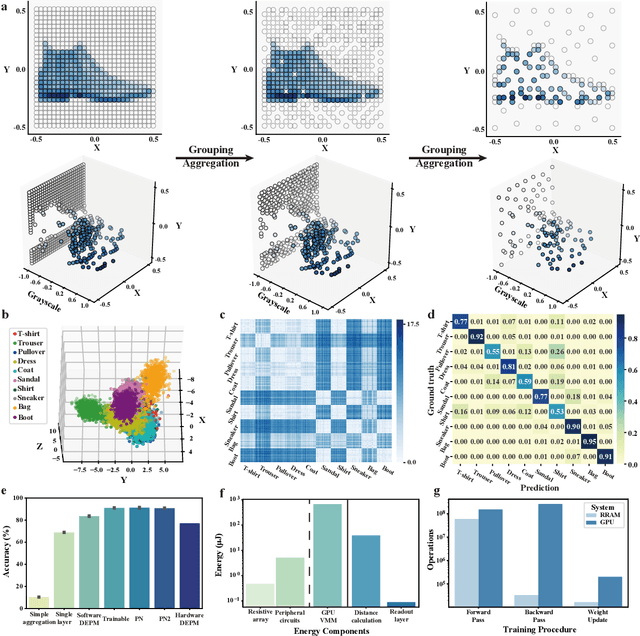
Abstract:Visual sensors, including 3D LiDAR, neuromorphic DVS sensors, and conventional frame cameras, are increasingly integrated into edge-side intelligent machines. Realizing intensive multi-sensory data analysis directly on edge intelligent machines is crucial for numerous emerging edge applications, such as augmented and virtual reality and unmanned aerial vehicles, which necessitates unified data representation, unprecedented hardware energy efficiency and rapid model training. However, multi-sensory data are intrinsically heterogeneous, causing significant complexity in the system development for edge-side intelligent machines. In addition, the performance of conventional digital hardware is limited by the physically separated processing and memory units, known as the von Neumann bottleneck, and the physical limit of transistor scaling, which contributes to the slowdown of Moore's law. These limitations are further intensified by the tedious training of models with ever-increasing sizes. We propose a novel hardware-software co-design, random resistive memory-based deep extreme point learning machine (DEPLM), that offers efficient unified point set analysis. We show the system's versatility across various data modalities and two different learning tasks. Compared to a conventional digital hardware-based system, our co-design system achieves huge energy efficiency improvements and training cost reduction when compared to conventional systems. Our random resistive memory-based deep extreme point learning machine may pave the way for energy-efficient and training-friendly edge AI across various data modalities and tasks.
DyBit: Dynamic Bit-Precision Numbers for Efficient Quantized Neural Network Inference
Feb 24, 2023Abstract:To accelerate the inference of deep neural networks (DNNs), quantization with low-bitwidth numbers is actively researched. A prominent challenge is to quantize the DNN models into low-bitwidth numbers without significant accuracy degradation, especially at very low bitwidths (< 8 bits). This work targets an adaptive data representation with variable-length encoding called DyBit. DyBit can dynamically adjust the precision and range of separate bit-field to be adapted to the DNN weights/activations distribution. We also propose a hardware-aware quantization framework with a mixed-precision accelerator to trade-off the inference accuracy and speedup. Experimental results demonstrate that the inference accuracy via DyBit is 1.997% higher than the state-of-the-art at 4-bit quantization, and the proposed framework can achieve up to 8.1x speedup compared with the original model.
COTS: Collaborative Two-Stream Vision-Language Pre-Training Model for Cross-Modal Retrieval
Apr 15, 2022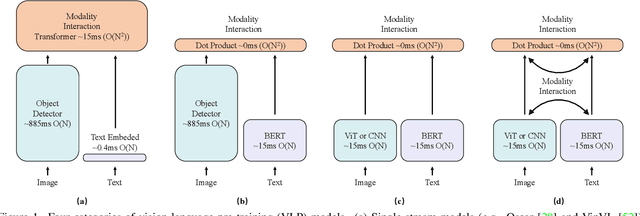
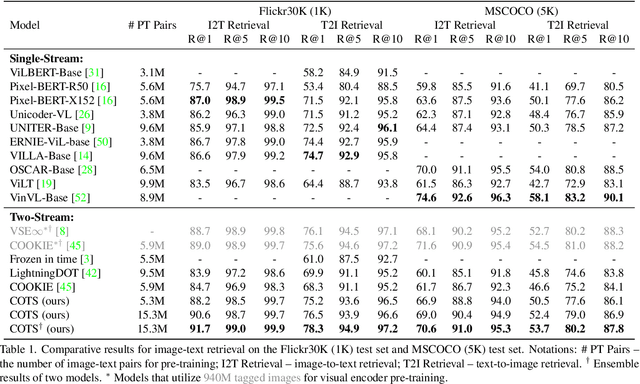
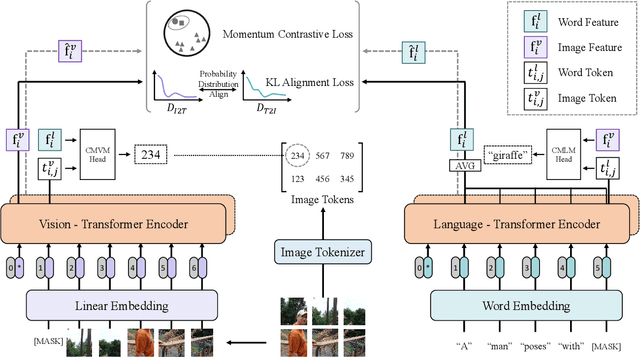
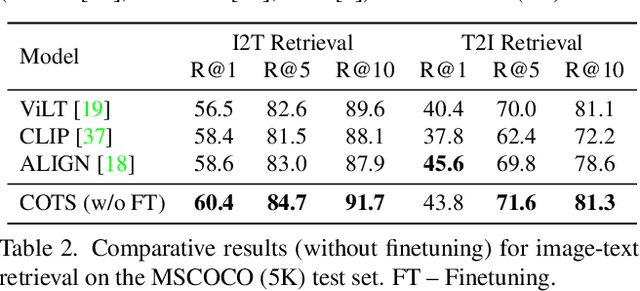
Abstract:Large-scale single-stream pre-training has shown dramatic performance in image-text retrieval. Regrettably, it faces low inference efficiency due to heavy attention layers. Recently, two-stream methods like CLIP and ALIGN with high inference efficiency have also shown promising performance, however, they only consider instance-level alignment between the two streams (thus there is still room for improvement). To overcome these limitations, we propose a novel COllaborative Two-Stream vision-language pretraining model termed COTS for image-text retrieval by enhancing cross-modal interaction. In addition to instance level alignment via momentum contrastive learning, we leverage two extra levels of cross-modal interactions in our COTS: (1) Token-level interaction - a masked visionlanguage modeling (MVLM) learning objective is devised without using a cross-stream network module, where variational autoencoder is imposed on the visual encoder to generate visual tokens for each image. (2) Task-level interaction - a KL-alignment learning objective is devised between text-to-image and image-to-text retrieval tasks, where the probability distribution per task is computed with the negative queues in momentum contrastive learning. Under a fair comparison setting, our COTS achieves the highest performance among all two-stream methods and comparable performance (but with 10,800X faster in inference) w.r.t. the latest single-stream methods. Importantly, our COTS is also applicable to text-to-video retrieval, yielding new state-ofthe-art on the widely-used MSR-VTT dataset.
A Roadmap for Big Model
Apr 02, 2022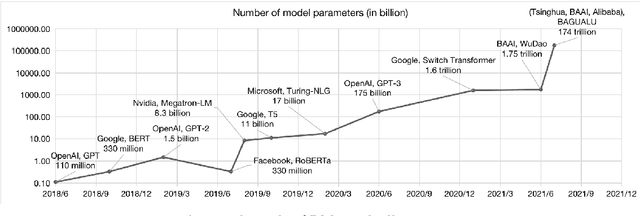

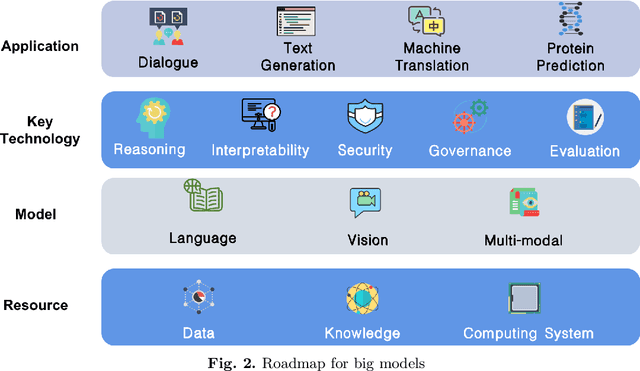
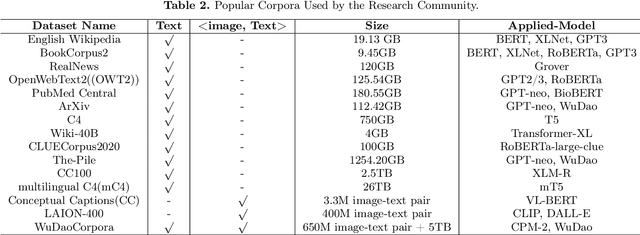
Abstract:With the rapid development of deep learning, training Big Models (BMs) for multiple downstream tasks becomes a popular paradigm. Researchers have achieved various outcomes in the construction of BMs and the BM application in many fields. At present, there is a lack of research work that sorts out the overall progress of BMs and guides the follow-up research. In this paper, we cover not only the BM technologies themselves but also the prerequisites for BM training and applications with BMs, dividing the BM review into four parts: Resource, Models, Key Technologies and Application. We introduce 16 specific BM-related topics in those four parts, they are Data, Knowledge, Computing System, Parallel Training System, Language Model, Vision Model, Multi-modal Model, Theory&Interpretability, Commonsense Reasoning, Reliability&Security, Governance, Evaluation, Machine Translation, Text Generation, Dialogue and Protein Research. In each topic, we summarize clearly the current studies and propose some future research directions. At the end of this paper, we conclude the further development of BMs in a more general view.
 Add to Chrome
Add to Chrome Add to Firefox
Add to Firefox Add to Edge
Add to Edge